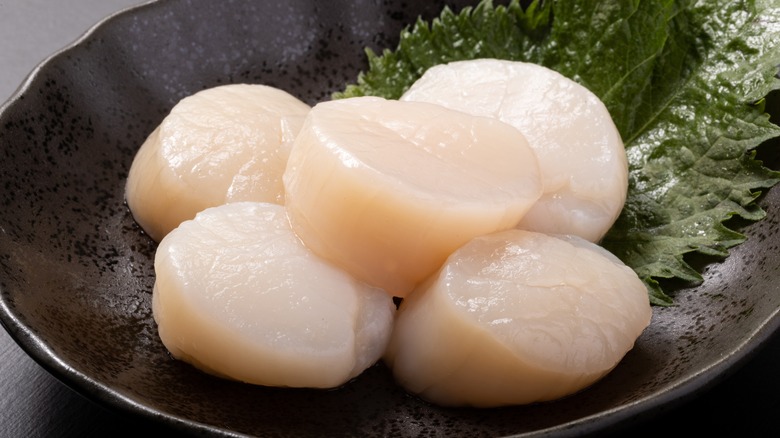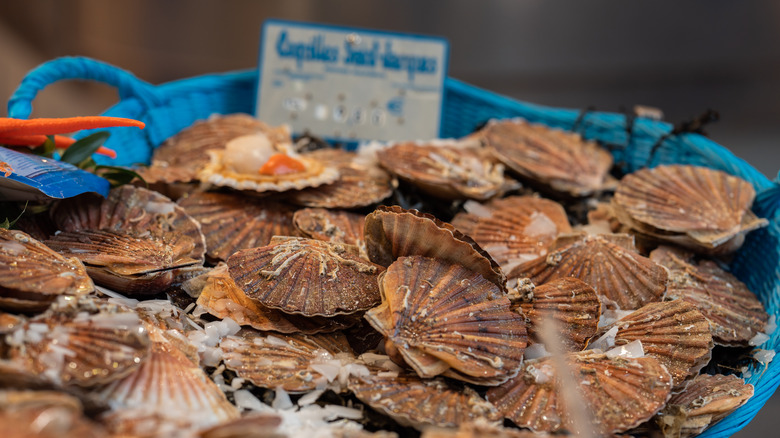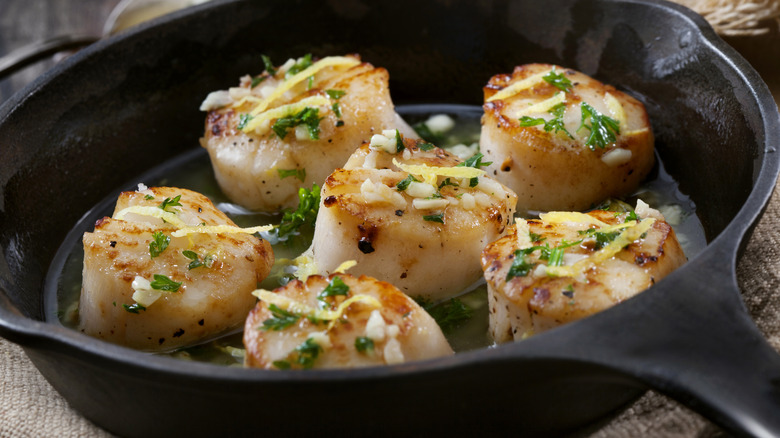When Shopping For Scallops, Make Sure They're Dry
When it comes to seafood, fresh scallops are hard to beat. However, there's a trick to ensuring that your seafood dinner hits all the right notes when it comes to flavor and texture. Some scallops include certain preservatives, as well as an excess of water, which is known as wet packing. Savvy seafood companies use the wet packing process for two reasons. More moisture means a heavier scallop, which means stores can charge more for the seafood. Keep in mind that scallops are pretty pricey as it is. As for chemical preservatives, they ensure that scallops last longer than dry-packed varieties might.
While this is good for the businesses that provide fresh seafood, it's not so great for consumers. All that water inside the scallops will evaporate during cooking, which can leave you with a puny outcome. Also, wet-packed scallops sometimes have an unpalatable flavor compared to dry-packed scallops. Accordingly, home chefs are encouraged to opt for dry-packed scallops whenever possible to ensure the best results.
How to choose quality scallops
In most instances, the ingredient list on wet scallop packs will include information on the inclusion of preservatives. However, you can't always trust that this information will be easy to access, which could lead to you inadvertently buying wet scallops instead of dry. Fortunately, there's a relatively easy method you can use to determine whether you made the right choice for dinner. Start by putting a paper towel on a dish, then plop a scallop on top of it. Set the microwave to high and nuke the scallop for approximately 15 seconds. When it's finished cooking, look at the paper towel under the mollusk.
Because wet scallops retain a lot more moisture due to the added preservatives, they will leave an excess of water on the paper towel. Conversely, a dry scallop will only release a small amount of moisture. While it's best to avoid common scallop mistakes in the first place, all hope is not lost if you do pick up wet scallops in error. Try submerging them in a solution consisting of water, salt, and lemon juice for a half hour before cooking. This solution should make for a more palatable flavor and prevent your dinner from being ruined.
How to get a nice sear on dry scallops
In addition to avoiding wet scallops whenever possible, there are a few helpful tricks to ensure searing success when preparing this tasty mollusk. Before adding scallops to the pan, be sure to remove any excess moisture with a paper towel. Excess moisture can actually steam scallops in the hot skillet, which can then result in an unsatisfactory texture. Similarly, choose your pan wisely when cooking scallops. While non-stick pans are great for avoiding messes in the kitchen, they're not so good for creating a delectable texture. In this case, stainless steel or cast-iron pans are highly recommended.
Your technique also matters when it comes to searing scallops. For the best results, avoid moving them in the pan as they cook. Instead, place the scallops in the hot oil and allow them to cook for two minutes. Once enough time has elapsed, flip the scallops over. Remove them from the pan about 30 seconds after flipping, as any longer could burn the delicate mollusk. These tips ensure any future pan-seared scallop recipes you create in your home will be rich and flavorful.


